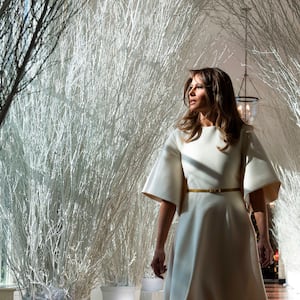During her first solo tour through Africa, Melania Trump channeled every study-abroad student, posing in front of the Egypt’s pyramids or Kenyan elephants in ‘grammable photo opps. The First Lady told reporters that she wanted to “show the world that we care,” with her travels through Ghana, Malawi, Kenya, and Egypt.
“The world” (mostly Twitter) did notice something—the pith hat she donned in Nairobi. For many, the accessory referenced colonialism and oppression, especially in light of her husband’s reported opinion of Africa being made up of “shithole countries.”
When asked about the accessory during a press conference in front of the Sphinx, Trump echoed the irked statement her press office made after she donned a controversial “I REALLY DON’T CARE, DO U?” jacket while visiting immigrant child detention facilities in June. “I wish people would focus on what I do, not what I wear,” she said.
But as University of California, Riverside political science professor Kim Yi Dionne told The New York Times, much of what Trump did also reinforced colonial attitudes. “Her attire is a signal of her understanding of what Africa is in 2018. It’s tired and it’s old and it’s inaccurate,” Donne said.
The professor created the #FLOTUSInAfricaBingo hashtag to call attention to the stereotypical, white savior aspects of Trump’s trip such as visiting orphans and going on safari.
Of course, Trump isn’t the only first lady whose sartorial moves are highly analyzed. During her time in the White House, Michelle Obama’s every outfit garnered attention, from her J. Crew obsession to her many colorful frocks.
Every first lady curates an image, which serves as shorthand for their personalities and mindset. Yes, that image should take a backseat to their actions, but if their actions don't amount to much, then the clothes end up inevitably doing a lot more of the talking.
When the notoriously reserved, often absent Melania Trump does step out, she stays relatively silent. Her main focus, the #BeBest campaign has a confusing, intangible goal—to "concentrate on three main pillars: well-being, social media use, and opioid abuse."
On the rare occasion she does speak to the press, such as her conference in front of the Sphinx, her answers seem canned and sanitized to a meaningless extent. Take, for instance, how she attempted empathy for Dr. Christine Blasey Ford while maintaining support for Brett Kavanaugh: “I am against any kind of abuse or violence.” Radical.
And so we are left with the cream suit and tie Trump wore to her Giza press conference, which drew comparisons to Peter O’Toole in Lawrence of Arabia or Indiana Jones’ French rival, Dr. René Belloq.
The snarks and jokes are an inevitable part of a social media culture. But Melania is not alone in having her first lady wardrobe picked over: Nancy Reagan's glitzy gowns excited much comment in the '80s (particularly opposite Raisa Gorbachev).

U.S. first lady Melania Trump visits the Pyramids in Cairo, Egypt, October 6, 2018.
Carlo Allegri/ReutersHillary Clinton's hair and wardrobe were similarly analyzed and criticized, as was Michelle Obama's. If you are a high-profile person, particularly a woman, a visual culture inevitably obsesses over how you look—alongside what you do and say.
While analyzing the tweets that lampooned the first lady's attire, Vanessa Friedman wrote that Trump “still seems dedicated to dressing a part.” If anything, Trump’s affinity for khaki, trench coats, and buttoned-up silhouettes such as the long, denim blue dress she wore while visiting the crash site of Flight 93, communicate a desire to masquerade or hide in plain sight.
As a former model, Trump knows the power of speaking through dress. There’s a kind of gaslighting that comes with rolling your eyes and telling people to “get over” what you wear, when (for better or for worse) dressing is part of your job, and when you are wearing highly stylized clothes and not saying very much about anything.
Yes, it would be sexist if Twitter was playing Fashion Police, criticizing the first lady simply for being unstylish. But that's not what's happening. Instead, social media users are reading into Trump's choreographed wardrobe, and holding her to account for what she wears and what (little) she says.
It may be of small comfort to Melania, but there is a sartorial equality here. After all, Donald Trump, and his ever-girthy ties, deal with the same kind of scrutiny, too.
One solution: Melania could wear the same, unexciting, demure clothes as Laura Bush did and speak and do a lot more—and then people perhaps wouldn't focus so much on what she wore.







